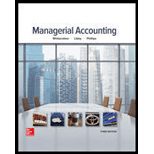
Concept introduction:
Activity Based Costing (ABC):
ABC costing method is generally used to allocate the
Predetermined Overhead allocation rate:
The Predetermined Overhead allocation rate is used to allocate the manufacturing overhead over the jobs. Predetermined Overhead allocation rate is calculated by dividing the Total Estimated overhead cost by the Total Estimated allocation base.
The formula to calculate the Predetermined Overhead allocation rate is as follows:
To indicate:
The reason for difference in product costs under traditional and ABC method
Want to see the full answer?
Check out a sample textbook solution
Chapter 4 Solutions
Managerial Accounting
- Net sales total $680,000. Beginning and ending accounts receivable are $58,000 and $64,000, respectively. Calculate days' sales in receivables. HELParrow_forwardProvide answerarrow_forwardA machine has a cost of $18,500, an estimated residual value of $4,500, and an estimated useful life of five years. The machine is being depreciated on a straight-line basis. At the end of the second year, what amount will be reported for accumulated depreciation? Questionarrow_forward
 Managerial Accounting: The Cornerstone of Busines...AccountingISBN:9781337115773Author:Maryanne M. Mowen, Don R. Hansen, Dan L. HeitgerPublisher:Cengage Learning
Managerial Accounting: The Cornerstone of Busines...AccountingISBN:9781337115773Author:Maryanne M. Mowen, Don R. Hansen, Dan L. HeitgerPublisher:Cengage Learning Cornerstones of Cost Management (Cornerstones Ser...AccountingISBN:9781305970663Author:Don R. Hansen, Maryanne M. MowenPublisher:Cengage Learning
Cornerstones of Cost Management (Cornerstones Ser...AccountingISBN:9781305970663Author:Don R. Hansen, Maryanne M. MowenPublisher:Cengage Learning Managerial AccountingAccountingISBN:9781337912020Author:Carl Warren, Ph.d. Cma William B. TaylerPublisher:South-Western College Pub
Managerial AccountingAccountingISBN:9781337912020Author:Carl Warren, Ph.d. Cma William B. TaylerPublisher:South-Western College Pub- Principles of Accounting Volume 2AccountingISBN:9781947172609Author:OpenStaxPublisher:OpenStax College



